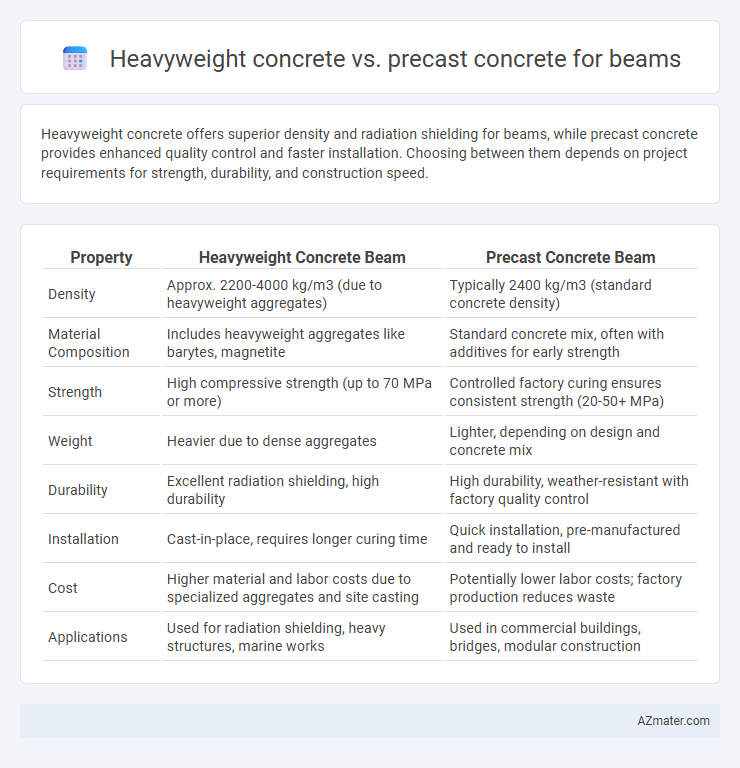Heavyweight concrete offers superior density and radiation shielding for beams, while precast concrete provides enhanced quality control and faster installation. Choosing between them depends on project requirements for strength, durability, and construction speed.
Table of Comparison
| Property | Heavyweight Concrete Beam | Precast Concrete Beam |
|---|---|---|
| Density | Approx. 2200-4000 kg/m3 (due to heavyweight aggregates) | Typically 2400 kg/m3 (standard concrete density) |
| Material Composition | Includes heavyweight aggregates like barytes, magnetite | Standard concrete mix, often with additives for early strength |
| Strength | High compressive strength (up to 70 MPa or more) | Controlled factory curing ensures consistent strength (20-50+ MPa) |
| Weight | Heavier due to dense aggregates | Lighter, depending on design and concrete mix |
| Durability | Excellent radiation shielding, high durability | High durability, weather-resistant with factory quality control |
| Installation | Cast-in-place, requires longer curing time | Quick installation, pre-manufactured and ready to install |
| Cost | Higher material and labor costs due to specialized aggregates and site casting | Potentially lower labor costs; factory production reduces waste |
| Applications | Used for radiation shielding, heavy structures, marine works | Used in commercial buildings, bridges, modular construction |
Introduction to Heavyweight and Precast Concrete Beams
Heavyweight concrete beams utilize dense aggregates like barite or magnetite to increase mass and improve radiation shielding, making them ideal for nuclear facilities and medical imaging rooms. Precast concrete beams are factory-manufactured under controlled conditions, ensuring high precision, consistent quality, and faster on-site installation for commercial and infrastructure projects. Both beam types offer structural strength but differ in weight, durability, and application depending on project requirements.
Composition and Material Properties
Heavyweight concrete beams are composed primarily of heavyweight aggregates such as magnetite, barite, or hematite, which increase density and provide superior radiation shielding and load-bearing capacity. Precast concrete beams typically utilize normal-weight aggregates and are manufactured off-site under controlled conditions, ensuring consistent material properties and enhanced durability. The material properties of heavyweight concrete, including higher density (typically 3000-4000 kg/m3) and improved compressive strength, contrast with precast concrete's rapid strength gain and dimensional accuracy due to factory curing processes.
Structural Performance and Load-Bearing Capacity
Heavyweight concrete offers superior density and compressive strength compared to precast concrete, enhancing beam structural performance under high load conditions. Precast concrete beams provide consistent quality and controlled curing, resulting in reliable load-bearing capacity and reduced on-site construction time. Choosing between heavyweight and precast concrete depends on project-specific demands for strength, durability, and installation efficiency.
Durability and Longevity
Heavyweight concrete beams offer superior durability due to their dense aggregate composition, providing enhanced resistance to impact, fire, and radiation compared to standard precast concrete beams. Precast concrete beams benefit from factory-controlled curing processes that ensure consistent quality and reduce the likelihood of defects, contributing to their long-term structural performance. Both options provide significant longevity, but heavyweight concrete is particularly advantageous in environments requiring high durability against harsh conditions.
Construction Speed and Efficiency
Heavyweight concrete beams significantly improve structural mass and durability but require longer curing times, which can slow down construction speed compared to precast concrete beams. Precast concrete beams are manufactured in controlled environments, allowing for rapid onsite installation and enhanced construction efficiency by reducing labor and weather-related delays. The choice between heavyweight and precast concrete beams often hinges on project timelines, with precast offering faster turnaround for tight schedules.
Cost Comparison and Budget Considerations
Heavyweight concrete beams typically incur higher material costs due to the use of dense aggregates like hematite or magnetite, increasing overall project budgets. Precast concrete beams offer cost advantages by reducing labor expenses and construction time through factory fabrication and standardized production. Budget considerations should factor in transportation and installation costs for precast beams, which may offset some savings compared to onsite casting of heavyweight concrete.
Environmental Impact and Sustainability
Heavyweight concrete, incorporating high-density aggregates such as magnetite or barite, offers superior radiation shielding but has a higher environmental footprint due to the energy-intensive extraction and processing of these materials. Precast concrete beams, produced in controlled factory settings, reduce waste and allow for efficient reuse of formwork, significantly lowering carbon emissions through optimized mixing and curing processes. Sustainable practices in precast concrete manufacturing, including the use of recycled aggregates and supplementary cementitious materials, enhance environmental benefits compared to the typically higher embodied energy associated with heavyweight concrete production.
Applications in Modern Construction
Heavyweight concrete, known for its enhanced density and radiation shielding properties, is ideal for nuclear power plants, medical facilities, and underwater structures where protection and durability are critical. Precast concrete beams offer accelerated construction timelines and superior quality control, making them preferable for large-scale commercial buildings, bridges, and modular projects. Selecting between heavyweight and precast concrete beams depends on application-specific requirements such as structural load, environmental exposure, and project schedule constraints.
Maintenance Requirements
Heavyweight concrete beams require less frequent maintenance due to their enhanced durability and resistance to fire, radiation, and corrosion, making them ideal for infrastructure with high safety standards. Precast concrete beams offer consistent quality and faster installation, reducing on-site repairs and maintenance costs over time. Both materials benefit from routine inspections, but heavyweight concrete typically demands fewer interventions thanks to its dense aggregate composition.
Summary and Recommendation
Heavyweight concrete offers superior radiation shielding and higher density, making it ideal for beams in nuclear or medical facilities, while precast concrete provides controlled quality, faster installation, and consistent strength suited for large-scale construction. For projects requiring enhanced durability and custom reinforcement, heavyweight concrete beams are recommended, whereas precast beams are preferable for expedited timelines and modular design efficiency. Selecting between the two depends on project-specific needs such as load requirements, environmental exposure, and construction speed.

Infographic: Heavyweight concrete vs Precast concrete for Beam
 azmater.com
azmater.com